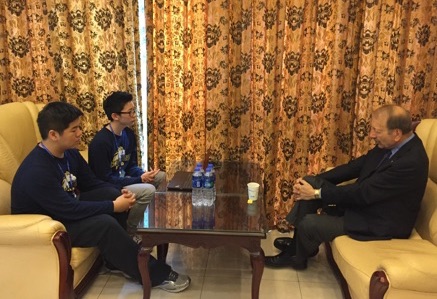A whirlwind trip to China

Chancellor Blumenthal was interviewed by two students from Shanghai High School.
Four cities in 11 days! Hardly enough time to adjust to the time difference, let alone get a handle on a country as big and complex as China. But the trip, which was organized around building relationships to foster study and research opportunities for students and faculty, was successful and rewarding on multiple levels.
We met with U.S. Ambassador Max Baucus, representatives of the Ministry of Education and the Chinese Scholarship Council, and attended two receptions with alumni and parents of current students. We visited several high schools and about 10 universities in Beijing, Shanghai, Nanjing, and Hongju.
As I mentioned in my monthly message, much of the itinerary was organized by Astronomy and Astrophysics Professor Doug Lin. Joel Ferguson, professor of computer engineering, senior international officer, and associate vice provost of international education, will be following up on connections we made to support study-abroad opportunities for UC Santa Cruz and Chinese students.
For me, one of my strongest and most lasting impressions is of the students I met. They were unfailingly bright, well-prepared, and eager to engage.
I had been invited to give an astronomy talk at the Beijing American Center, which is part of the U.S. Embassy complex in Beijing; the center hosts public talks every night by visiting American dignitaries and scholars, and about 150 people attended my talk. These drop-in sessions are open to everyone, yet the caliber of questions I fielded suggested many in the audience had a background in astronomy. I thoroughly enjoyed being cornered after the formal presentation by five students who wanted to keep talking and asking questions.
I also gave a talk at Shanghai High School as part of their Career Day, and I was particularly impressed by two student journalists who interviewed me for the school newspaper. They had clearly done their homework.
And no wonder. Students in China compete to get into the most elite public high schools, including Shanghai High School. Only about 1 percent of the population make the cut, and once there, they are in classes from 8 a.m. to 5 p.m. Students in these schools are considered the strongest prospects for overseas study. One school we visited teaches all physics classes in English only, because they consider the United States to be the best place to study physics and don't want their graduates to be at a disadvantage when they compete internationally. Needless to say, I gave my talks in English, but what's remarkable is the audiences didn't need translators.
All of the high schools and university campuses we visited were impressive. Some had the trappings of many American universities, with stately buildings, mature landscaping, and lush, leafy trees that arced over campus roads and walkways. I didn't spy a single Banana Slug, though!
Everywhere we traveled, our hosts were gracious and welcoming, and travel within China was efficient and comfortable. We flew from Beijing to Shanghai, then took the high-speed rail to Nanjing and Hongju. Zipping along at 250 mph in comfortable, clean train cars, I felt like I was getting a glimpse of the future.
The weather was mild, but the traffic was anything but! The roadways are unbelievably crowded, there are no lanes to speak of, and drivers toot their horns constantly. Amazingly, we saw no accidents. The surging river of cars flowed slowly, smoothly, unrelentingly—almost like a symphony, yet no conductor was in sight. I did pity the pedestrians, bicyclists, and anyone on a motorbike, though. How they survive the traffic was beyond my powers of comprehension.
Fortunately, the air pollution wasn't bad when we were in Beijing, though a UCSC alumna told us all flights had been cancelled the week before because of low visibility, so I guess we were lucky.
One final note about the food, all of which was delicious and presented beautifully. I enjoyed it all, especially the seafood, and I ate at least a couple of things I didn't recognize. That's all part of the adventure of overseas travel, right?
